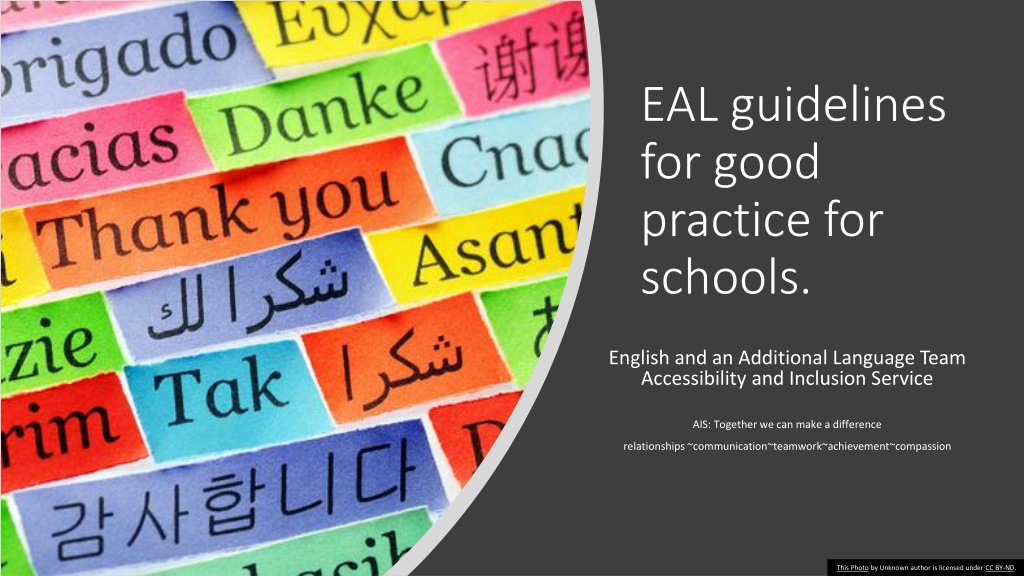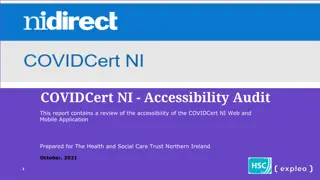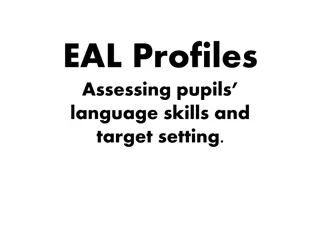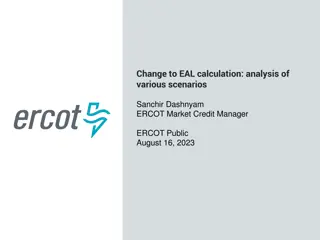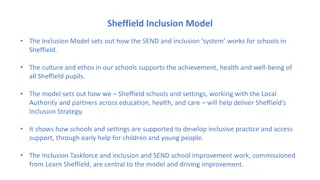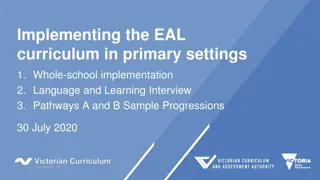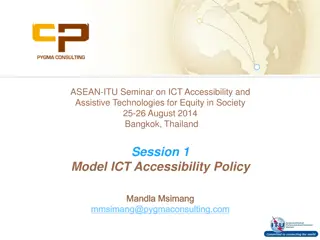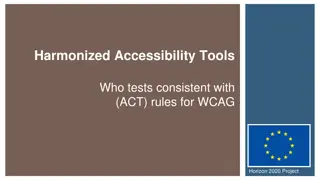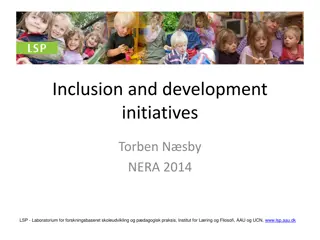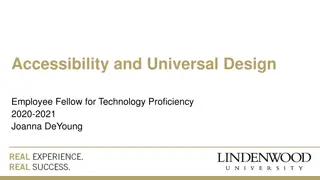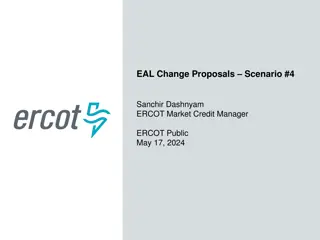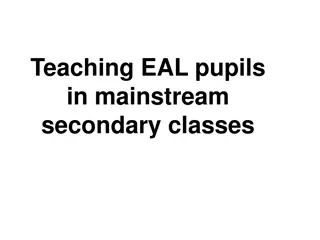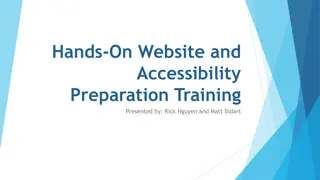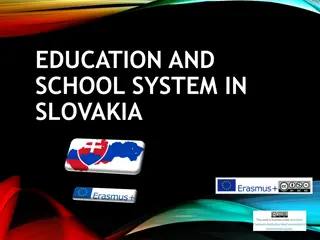EAL Guidelines for Schools: Enhancing Accessibility and Inclusion
Navigate effective guidelines for English and Additional Language teams in schools, focusing on fostering relationships, communication, teamwork, achievement, and compassion. As part of the Accessibility and Inclusion Service, together we can make a difference.
Download Presentation

Please find below an Image/Link to download the presentation.
The content on the website is provided AS IS for your information and personal use only. It may not be sold, licensed, or shared on other websites without obtaining consent from the author. Download presentation by click this link. If you encounter any issues during the download, it is possible that the publisher has removed the file from their server.
E N D
Presentation Transcript
EAL guidelines for good practice for schools. English and an Additional Language Team Accessibility and Inclusion Service AIS: Together we can make a difference relationships~communication~teamwork~achievement~compassion This Photo by Unknown author is licensed under CC BY-ND.
Our Mission Statement Our Mission Statement: The AIS EAL team works in partnership with parents/carers, schools and other agencies to promote equality of opportunity through the process of inclusion. Our work involves ensuring access to the curriculum, raising self-esteem and valuing bilingual children and young people s linguistic and cultural backgrounds.
Our team Background information Responsibilities for all Responsibilities for all Prioritising support Our roles and responsibilities Ensuring inclusion for new to English pupils contents contents Direct teaching support Partnership Home language Learning activities Enrolment of new pupils Early stages of learning English The role of the bilingual assistant Good practice advice for teachers
The EAL team: Depute Head Teacher Ruth McConnachie Principal Teachers: Anne Ferrier and Moreen Milne Teachers: Karolina Lewandowska, Gemma Soutar, Alison Wallace and Lynzy Mitchell Early Years Educator: Karen Hendry Bilingual Assistants
We are based at: St Paul's Academy, Gillburn Road, Dundee. EAL team: Contact: 01382 438079/438099 Accessibilityinclusion@dundeeschools.scot
Background information
To support education staff in meeting the needs of bilingual children and young people. To promote the welfare of bilingual children and young people within the school and the community so that they become successful learners, confident individuals, responsible citizens and effective contributors. (Scottish Executive - A Curriculum for Excellence) Our Aims To work in partnership with parents/carers, schools and other agencies to promote positive relationships. To promote equality of opportunity and to fulfil the potential of children and young people by valuing their bilingualism.
Background December 2022 Across the city of Dundee, there are a growing number of children in nursery, primary and secondary schools for whom English is not their first language. Many children are part of the settled community and speak languages such as Arabic, Bengali, Polish, Punjabi or Urdu. Over many years there has been an increase in the numbers of international workers arriving from Eastern European countries and settling with their families. Furthermore, there are short stay business and student communities, including asylum seekers and refugees, whose length of stay is uncertain and they have dependent children. Currently, 92 languages, other than English, are spoken in educational establishments in Dundee. In October 22, 1485 pupils were recorded as having English as an additional language.
We describe all children, for whom English is not their first language, as bilingual, i.e. children and young people who function in more than one language in their daily lives. The term bilingual emphasises that we acknowledge they already have one language, and that English is an additional language. The term does not imply an equal or specified level of proficiency in two or more languages. Defining bilingualism
Language implications for new pupils Bilingual children and young people may start school at any stage: nursery, primary or secondary and at any time throughout the school year. Some are immediately able to cope successfully, both socially and academically. Others, however, may be: Beginners in English. Children whose English has not yet fully developed. Children who speak English fluently but may not be achieving their full academic potential. Children who speak English but may experience difficulty adjusting to the Scottish Education System.
All Scotland's children and young people are entitled to support to enable them to gain as much as possible from the opportunities that Curriculum for Excellence provides. Some children may need additional support. Targeted support: Children and young people can benefit from additional or targeted support, tailored to their individual circumstances. This could be at any points of their learning journey or throughout the journey. Education Scotland - Inclusion Barriers to learning may arise from specific learning difficulties, disability, social, emotional or behavioural needs, bereavement or family issues. Additional support may also be required to ensure progress in learning for the gifted and able, looked after children and young people, young carers, Gypsies and Travellers, asylum seekers and those for whom English is not a first language. Targeted support also encompasses children and young people requiring more choices and more chances to achieve positive, sustained post-school destinations. This 'targeted' support is usually, but not exclusively, delivered by staff with additional training and expertise. In a secondary school, this support may be coordinated by guidance/pastoral care/pupil support staff through a staged intervention process.
All staff are responsible for meeting the needs of each learner, supported by EAL and bilingual local authority support services, as well as external agencies and community links. Getting it right for bilingual learners and their parents It is important that parents or carers and the child or young person are involved in the learning journey at all stages of their education. Schools should have a positive and welcoming ethos.
Prioritising support Tracking progress in English acquisition
The EAL team is an Outreach Service managed centrally. It is the policy of the EAL team to support bilingual children and young people according to their needs in collaboration with the school. When assessing a bilingual pupil's needs the following are taken into account: Pupil's exposure to English Pupil's English language proficiency (see Appendices Stages of English Language Acquisition and Checklists) Age and school stage Assessing Priority Previous educational experience Areas of under-achievement Length of stay (short stay are those who are here for up to 1 year) Additional support needs Previous experience of the school in supporting bilingual pupils Exceptional circumstances (e.g. refugees) On-going monitoring of the needs of pupils across the city is undertaken by the team and adjustments to the type and level of support offered is made where necessary.
Tracking and monitoring progress in English language acquisition Bilingual pupils make progress in acquiring English as an additional language in different ways and at different rates; however there are universally recognised broad stages in this development. All bilingual pupils in mainstream classes will be at one of these stages. It is generally accepted that progression from the first stage to a good command of social English takes 2 years and to fluency and a good command of academic English takes a minimum of a further 5 years. One of our main aims is to give bilingual children and young people access to the curriculum so that they can continue to develop cognitively while acquiring an additional language. English is best learned through the completion of meaningful tasks related to the curriculum.
Tracking and monitoring progress stages of English language acquisition Stage 1 new to English Stage 2- early acquisition Stage 3-developing competence Stage 4-competent Stage 5-fluent
Tracking and monitoring progress in English language acquisition The stage of English Language Acquisition is recorded for every bilingual pupil by the school, in addition to CfE levels of achievement. The stage of English Language Acquisition is transferred to SEEMIS for use in city-wide data collection and for use in the Scottish Executive census carried out in September. A single level stage is required for SEEMIS, scotXed and the EAL team even though learners may show characteristics of more than one level. It is important that this information is accurate. EAL team members are available to support and advise throughout this process. Class/subject teachers can track and monitor progress by updating the checklists (see appendix) annually for their bilingual learners. The professional judgement of all staff working with the pupils, class- based evidence, including observation and any other assessment tools in use would support this process. Information gathered through the annual EAL audit and completed by schools, provides evidence of pupils progress through the stages of language acquisition and allows the team to prioritise support.
Our roles and responsibilities
Roles and Responsibility collaboration with schools/Dundee House to process placing requests for new arrivals to the city, transfers within the city, primary one intake and secondary transition (see appendices for a flowchart detailing procedure) collaboration with schools to set up an enrolment meeting with parents/carers to exchange information regarding pupil background and education systems, using an interpreter and translated information where possible on -going contact with parents / carers to provide home-school communication regarding pupil progress, school events, local community groups and classes annual consultation in each school with a named school link person and an EAL teacher to review needs each school has a link teacher from the EAL team
Roles and responsibility supporting schools to provide accurate data on the Stages of English Language Acquisition for audits and the national census advising schools and nurseries on suitable resources, learning and teaching approaches, strategies, exam arrangements and other exam opportunities for bilingual learners direct support of identified pupils providing citywide ESOL classes for senior pupils maintaining links and developing partnership work with other agencies providing in service training to education staff and other agencies participating in DCC Education Department strategy groups
How we support additional language development Involving Parents Links with Other Agencies In-Service Training Collaboration on Target Setting and Assessment Advising Schools on Appropriate Resources Advising Schools on Differentiation of Resources Direct Teaching/Partnership Teaching Support in the Home Language Collaborative learning /Co-operative Learning We also aim to raise awareness among all children and staff of the diversity of Scotland s population and the need to promote equality of opportunity.
Including parents Schools will already have procedures in place for developing partnerships with parents/carers. However, additional issues need to be considered in the case of the parents/carers of bilingual learners. Consider whether the underlying ethos of the school is welcoming and reflects Scotland as a multicultural, multilingual country. Consider the enrolment interview as an opportunity to build trust and confidence in the school/nursery and encourage the involvement of parents in all aspects of school life. An interpreter should be present at the enrolment interview so that all parties can express themselves without fear of misunderstanding. Parents should be made aware of how they can access school information. Leaflets in a range of languages should be available via the school office or websites. Consider whether parents who have come from a different education system understand the Scottish Education System, the curriculum, methodology, pastoral care and the key role of parents.
Links with other agencies Schools will already have procedures in place to identify strategies to support children and young people, such as ABLe and will have established links with other agencies and organisations to support the educational and pastoral needs of all children. However, links may need to be supported with agencies in the case of bilingual children and young people. Bilingual children may have other additional support needs, for example, a sensory impairment, a physical disability, social, emotional or behavioural difficulties or a specific language disorder. It is important to identify at an early stage any other additional need that is affecting academic or social development. Where the child is not making the expected progress it may not be clear whether this is because of accessing the curriculum through English as an additional language or because of a specific barrier to learning. In such cases, we can facilitate links with appropriate agencies, the school and the parents for further assessment. For example, our Bilingual Assistants work alongside Speech Therapists, assessing overall language development in both languages and interpreting for parents.
Staff training opportunities The EAL team can provide training suited to your school/nursery's needs. This can be: Whole staff presentations Targeted group staff training Collaboration with individual teachers to explore support strategies for a specific pupil/group of pupils Self-study activities via the CLPL padlet Citywide training via MyLearn To arrange training contact your link from the EAL team. There is also an e-learning module Valuing Bilingualism accessible to staff.
Ensuring inclusion for new to English pupils
key visuals - e.g. tables, maps, diagrams - these provide information in a graphical rather than verbal form pictures and photographs artefacts and props bilingual dictionaries simplified texts and text summaries adapted worksheets to allow children to read and write small chunks of information texts in children's home language audio-visual resources games ICT apps and programmes such as Clicker resources that reflect children's previous experience and background Useful resources for children new to English
Planning inclusive activities Understanding the scope and content of texts before reading gives a greater chance of making sense of the written word. Pair and small group work is vital, since whole class discussions are often inaccessible. Photographs, drawings and diagrams convey meaning without reliance on text. Collaborative writing with other children who share the home language gives opportunities to take part in the composition process Labelling, matching and sentence completion provide text-reduced opportunities to show understanding of content. Writing from a model or a choice table gives the chance to use repetitive structures while using new vocabulary. Sequencing simple sentences to give a factual account can then be linked to form a continuous piece of writing.
Making learning challenging differentiating materials and approaches for children and young people new to English. However, consideration must also be given to the children's cognitive ability and prior attainment. It is important to consider the level of English Language Acquisition when thinking ranging from cognitively undemanding such as naming, copying or identifying to cognitively demanding such as hypothesising, analysing or evaluating. Bilingual children should have opportunities to experience different types of Cummins Quadrant can start with existing knowledge and experience and move towards making sense of new learning. Cognitively challenging activities should be well-contextualised so that children (Cummins 1996) provides a useful tool for analysing classroom tasks
Direct teaching support
EAL team direct teaching Our team members work with bilingual learners in many different ways. The content of this input will be discussed with class or subject teachers and SFL staff with targets being set and records being kept. Stage 1 New to English children may need to be taught very basic vocabulary and phrases in order to help them in their social English. Stage 2 and 3 learners may need to learn some specific vocabulary and phrases which will be used in the mainstream class so that they are able to engage with the lesson and their peers.
EAL team direct teaching ESOL provision In Secondary schools the EAL staff deliver, assess and quality assure the SQA ESOL courses. ESOL could be offered as a subject choice to those bilingual pupils in S4 and above who require the language support. This generally benefits their access to and understanding of other subjects on the curriculum. In S5/6 NQ Higher ESOL can help bilingual pupils access University as it is a recognised English qualification. https://sway.office.com/nDeFg8WC3Y6uXzxs?ref=Link
This sway explains about the ways in which we can work with schools. Partnership with schools https://sway.office.com/ka9An3caxNqTCbgq ?ref=Link
We can support class/subject teachers with the planning for teaching bilingual learners, assessment and review of child progress. A bilingual pupil may have differentiated materials, tasks and outcomes. For good collaborative practice, joint planning time must be made available for school and EAL staff. Within the classroom EAL staff may provide more explicit instruction and concept checking. Bilingual children and young people may have prior knowledge and learning which they are unable to communicate in English. EAL staff can provide and highlight good models of English language and ensure the bilingual pupil has the opportunity for repetition and practice of the newly acquired language. EAL staff may facilitate group work so that the bilingual pupil begins to learn from their peers. Writing, speaking and note-taking frames may be incorporated into the lesson by the EAL staff to aid learning and help bilingual children to scaffold the language. Bilingual children and young people are encouraged to use their L1 and bilingual dictionaries to support their learning. Teaching in partnership
Valuing the home language (L1) A strong foundation in the home language is a major factor in enhancing the achievement and self- esteem of bilingual learners. Research also shows that learners, who develop an additional language, whilst their home language is strongly supported, experience definite cognitive benefits. The home language of the pupil should be valued by the school. As the pupil progresses through the stages of language acquisition, it is vital that the home language is maintained and developed.
Using the home language (L1) A strong foundation in the home language is a major factor in enhancing the achievement and self esteem of bilingual learners. Research also shows that learners, who develop an additional language, whilst their home language is strongly supported, experience definite cognitive benefits. Home languages and culture should be given a positive place within our schools and parents should be encouraged to work in partnership in promoting and developing their child s first language. Children and young people who are new to English will be able to show their competence through their home language, particularly if they have literacy skills. Whenever possible, bilingual assistants who share the home language should support children so that they can display their skills and knowledge across the curriculum.
Using the home language (L1) In addition there is much the school can do to maintain a positive ethos towards the use of the home language. Encourage pupils to talk together in home languages Value and praise bilingual competence Treat heritage visits as a positive experience Welcome home language support from bilingual staff Encourage the use of bilingual dictionaries and word lists Encourage literate pupils to read and write in their home language Provide books written in different languages Encourage children and young people to attend community language classes Present senior pupils for home language examinations
Learning activities
Information Gap: this is one of the simplest ways of encouraging pupils to interact. Using charts, graphs, timelines or text, one pupil has information that the other needs. They must ask and answer questions to complete the task. Collaborative learning tasks Matching Activities: help pupils to explore thinking and language skills such as identifying, describing or defining cause and effect. Collaborative learning activities were developed in the 1980s to provide opportunities for children and young people to use their own experience, ideas and abilities to make connections with new learning and interact with other children and young people. They encourage children and young people to think and talk about subject matter in a reflective, problem- solving way. Collaborative learning activities maximise participation for all therefore giving bilingual learners a sense of belonging. Collaborative learning activities will include: Sorting Activities: this type of activity encourages children to apply criteria and use the thinking and language of classification, generalising or defining a group. Sequencing Activities: in order to complete a task pupils have to collaborate while thinking and talking about the order of events, instructions or descriptions of processes. Ranking Activities: by organising items or people according to a given criteria, pupils are encouraged to evaluate, estimate, measure or judge while using the appropriate language required.
Co-operative learning It may be that the bilingual pupil can contribute to the task in his/her home language or may have some skills or knowledge from their previouseducational experience. All co-operative learning should have the 5 basic elements Positive Interdependence Individual Accountability Group Processing Social skills Face to Face Interaction The team building exercises in co-operative learning should help the bilingual pupil feel confident enough to make a contribution. These elements will also contribute to the development of English Language Acquisition. The language components of the activities and the role given need to be well planned for a bilingual pupil at the early stages of ELA. Bilingual pupils will benefit linguistically from being part of the group both academically and socially.
Enrolment of new pupils
For full procedure see the flowchart Best practice Check the home language spoken by the child. If it is not English - Send the placing request to: Your EAL link teacher Accessibilityinclusion@dundeeschools.scot Admission procedures Do not enrol the child without contacting your EAL link teacher. All EAL pupils should be allocated a space in the appropriate year group for their age regardless of level of English.
Enrolment Procedure for Bilingual New Arrivals The enrolment process is the key to a smooth transition into school. It provides an opportunity to establish good home/school relations and develop confidence in parents, children and staff. Your EAL teacher will: Arrange an interpreter for the meeting. Make contact with the family via the interpreter to agree a date for an enrolment meeting. Attend the enrolment meeting and share key information from the checklist and support parents with data collection. Collect background information about the pupils' prior learning to share with school staff. Arrange the enrolment meeting in partnership with your EAL teacher.
Early stages of learning English
The Early Stages of Learning English This outline of the development of young children's learning of English as an additional language draws on research findings. Although the process follows a particular sequence, it is flexible. Rather than moving through stages, think of the development in terms of waves - moving forward, receding, then moving forward again. (Olsen Edwards 1994) Many children at the early stages of learning English go through a 'silent period'. This can last up to six months or longer. This is not a passive stage. Children will be listening and making sense of their new environment. They should not be pressurised to speak until they feel comfortable, however, adults should continue to talk to the children and involve them in activities. During this wave, children may begin to use non-verbal gestures in response to questions or to indicate a need. Understanding is in advance of spoken language. Many children may begin to 'echo' single words and short phrases used by adults and peers. All attempts at speech should be encouraged and praised.
